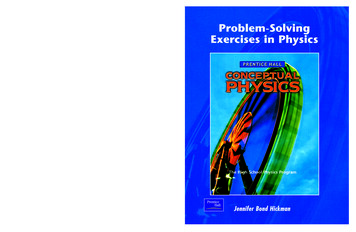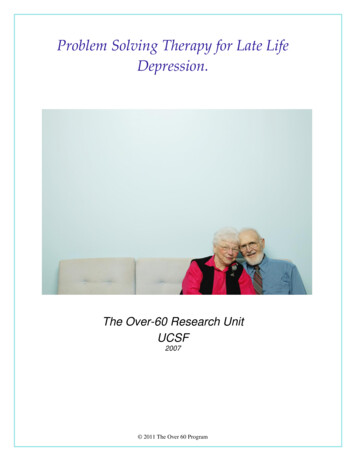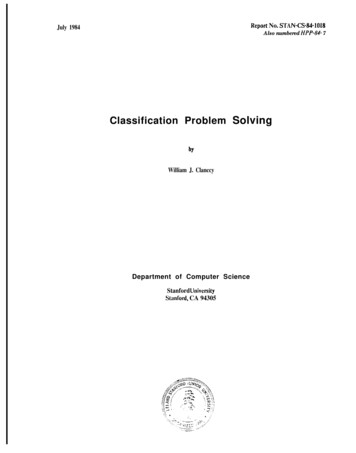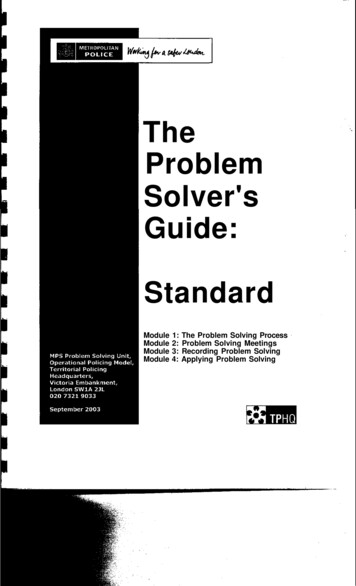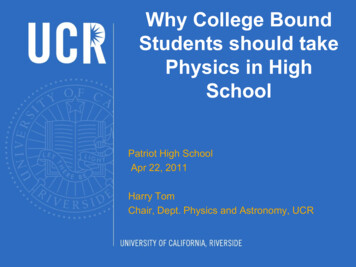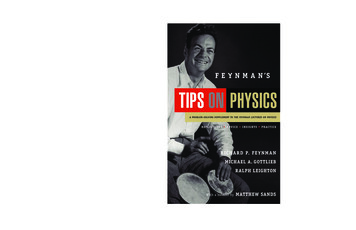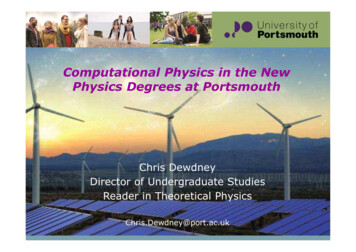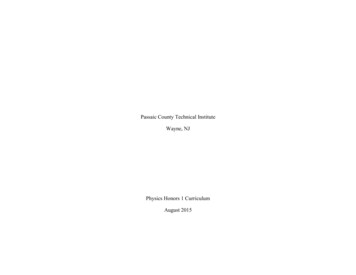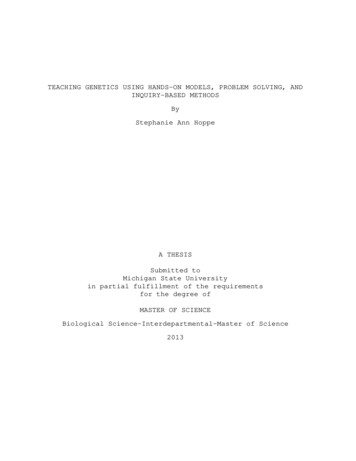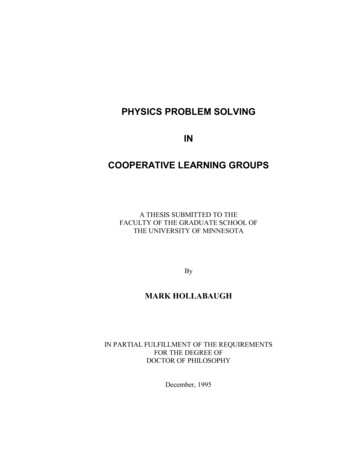
Transcription
PHYSICS PROBLEM SOLVINGINCOOPERATIVE LEARNING GROUPSA THESIS SUBMITTED TO THEFACULTY OF THE GRADUATE SCHOOL OFTHE UNIVERSITY OF MINNESOTAByMARK HOLLABAUGHIN PARTIAL FULFILLMENT OF THE REQUIREMENTSFOR THE DEGREE OFDOCTOR OF PHILOSOPHYDecember, 1995
PHYSICS PROBLEM SOLVINGINCOOPERATIVE LEARNING GROUPSCopyright Ó 1995 by Mark HollabaughAll rights reserved. This dissertation may not be reproduced, copied, or distributed inany form without the permission of the copyright holder.
DEDICATIONThis dissertation is dedicated to the memory of my grandparents, Herb and HildaPotter, who were with me at every great step in my life; and to the memory of my uncle,Hank Helmke, a great fifth grade teacher and an even greater uncle.
ACKNOWLEDGMENTSThere are numerous people I wish to thank for encouraging me, prodding me,helping me and inspiring me. To my friends and relatives: You will never again hear mesay, “I’m sorry, I can’t, I have to work on my dissertation.” To my former colleagues atWCAL-FM, St. Olaf College, thanks for the tunes that kept me sane on weekendafternoons.Dr. Konrad Mauersberger, now of the Max Planck Institute, graciously agreed tomy videotaping of his Physics 1041 and 1042 students. When I served as Konrad’steaching assistant, I learned much about teaching physics from a master teacher. Without the cooperation of the Physics 1041 and 1042, this research would not have beenpossible. Thanks gang!Several other University of Minnesota faculty where helpful: Dr. FrancesLawrenz of the Department of Curriculum and Instruction, provided me with references,encouragement, thoughtful questions, and ideas. Dr. David Johnson introduced me togroup dynamics. Dr. Don MacEachern taught me everything known about statisticalanalysis in education, and I apologize to Don that there is only one ANOVA in thisdissertation! Dr. Roger Jones asked me to team-teach a calculus-based physics courseand introduce cooperative group problem solving to our students. Dr. Kenneth Hellerlead the development of the problem-solving strategy and took a active interest in myresearch.My fellow science education graduate students kept asking me, “When are yougoing to finish?” Most of them beat me to the finish line but never hesitated to encourageme: Dr. Rob Lonning, Dr. Ron Keith, Dr. Bruce Palmquist, Dr. Doug Huffman, Dr. ValOlness. I am especially grateful to Ron and Bruce for volunteering to be videotapeoperators, and to Bruce for his thorough independent evaluations of the 14 group’swritten solutions. Scott Anderson carefully transcribed the videotapes.My thanks to the librarians at Normandale Community College who obtainedreference materials for me. Joyce Carey and Rex Gaskill of the Speech CommunicationDepartment provided me with numerous references on Toulmin and creative conflict ingroups. Dr. Bill Chartrand proof read the entire manuscript.
Many former teachers and colleagues encouraged me, expressed an interest in thiswork and made thoughtful comments: Dr. Jim Cederberg, Dr. Duane Olson, Dr. DaveNitz, Dr. Dave Dahl, Dr. Bob Jacobel, Dr. Amy Kolan, and former President Mel Georgeall of St. Olaf College; and colleagues from the American Association of PhysicsTeachers: Allan Van Heuvlen, Thomas Rossing, Herschel Neuman, Fred Goldberg,Curtis Heigelke, Roger Freedman, Peter Urone and Michael Zeilik.I am grateful to Dr. Roger Johnson (Cooperative Learning and ScienceEducation), Dr. Larry Rudnick (Astronomy), and Dr. Charles Campbell (Physics) foragreeing to serve on my final oral examination committee. The commitment of thesefaculty to cooperative group problem solving is very much appreciated.Two people never gave up on me: Dr. Patricia Heller and Dr. Fred Finley, myadvisers. Fred asked the hard questions and made me clarify my ideas. Pat, despite herown heavy teaching and research load, always made time for me, always asked the rightquestions, and never once failed to say “You’re doing a great job.” I could not haveasked for two better advisers. We form a well-functioning cooperative group of three!
ABSTRACTThis doctoral dissertation research investigated the process of argument coconstruction in 14 cooperative problem-solving groups in an algebra-based, college level,introductory physics course at the University of Minnesota. The results of the researchprovide a rich description of argument co-construction, which, while predicted inprevious literature, has not been systematically described. The research was a qualitative,case-study analysis of each group's discussion of the "physics description" portion of thegroup's problem solution. In a physics description physics concepts and principles areuse to qualitatively analyze the problem. Transcripts were made from videotapes and theanalysis focused on sequential groups of statements, called episodes, instead of isolated,individual statements. The groups' episodes were analyzed and described in terms ofStephen Toulmin's argument structure which consists of claims, grounds, warrants, andbackings.In 13 of these 14 cooperative problem-solving groups, students engaged in coconstructing an argument. The evidence for this is that the claim making shifted amonggroup members, and the lower performance students often provided importantcomponents of the solution in the form of skeptical questioning or grounds, warrants, andbackings. This means the physics description was a group product and not the work ofthe best individual in the group. This finding supports previous research.Individual groups adopted a "group dynamic" and showed a self-consistentargument pattern as they co-constructed a physics description. Group members usedadditional claim types: "Modified Claims" clarify initially correct or slightly ambiguousclaims and "Alternate Claims" correct initially incorrect or very ambiguous claims.These additional claims allowed the groups to engage in "creative controversy." Thegroups used grounds, warrants, and backings to support their claims. Their backingspreferred the professor over the teaching assistant or the textbook.
TABLE OF IST OF FIGURESxLIST OF TABLESxiiCHAPTER 1 - INTRODUCTIONStatement of the Problem4Purpose and Research Questions11Overview of the Research Design11Assumptions and Rationale for a Qualitative, Case-Study Design13Methodological Issues and Limitations of the Study15Significance of the Study25CHAPTER 2 - PROCEDURESThe Role of the Researcher27Research Context and Setting28Theoretical Foundations35Problem Solving Strategy35Cooperative Learning41Data Collection Procedures47Data Analysis Procedures50Initial Transcript CodingIdentification of Statement Types Using Descriptions of the SessionFour GroupsAdditional Quantitative and Qualitative DataSummary50546166
CHAPTER 3 - PATTERNS WITHIN A GROUPArgument Co-Construction68Question 1. Do these fourteen problem-solving groups engage in argumentco-construction as they complete a physics description?69Episodes and Interaction Analysis70Episode Delineation73Examples of Coded Discussions77Extension to The Remaining Groups100Summary101Question 2. Are there self consistent argument co-construction patternswithin a group?102Episode Flowcharts103Prototype Flowcharts106Multiple Claims in an Episode110Does a Group Have a Self-Consistent Pattern of ArgumentConstruction?118Co-Construction of the Argument Revisted122Summary131CHAPTER 4 - PATTERNS BETWEEN GROUPSQuestion 3. Are there similarities in the argument co-construction patternsbetween the fourteen groups?134Question 3a. Do their argument constructions begin or end with a Claim?134Question 3b. What roles do Modified Claims and Alternate Claims play inthe argument co-construction process of these groups?136Why do Some Groups Use Alternate Claims?137Creative Controversy139Why Do Some Groups Not Use Alternate Claims?155
The Role of Requests163Summary167Question 3c. Do the groups have a preferential means to support argumentconstruction?Summary169173CHAPTER 5 - DISCUSSION OF RESULTSResearch Summary177Reliability, Validity, and Generalizability Revisited184Descriptive Validity186Interpretive Validity187Theoretical Validity189Generalizability Validity190Significance of the Research190Suggestions for future Qualitative and Quantitative Research193Curriculum and Instruction Concerns196Epilogue198BIBLIOGRAPHY199APPENDIX A - GLOSSARY205APPENDIX B - THE SIX PROBLEMS209APPENDIX C - DETERMINING A PROTOTYPE EPISODE213APPENDIX D - PROTOTYPE EPISODE FLOWCHARTS221
LIST OF FIGURESChapter 11-11-2At The GasthausFour Points of Reference423At The GasthausToulmin Analysis of At The Gasthaus.5153Chapter 22-12-2Chapter 33-13-23-33-43-53-63-73-83-93-103-11Group 4A, Episode 5, lines 30-38, FlowchartKey to Original Flowchart SymbolsGroup 4D Prototype EpisodeGroup 4B, Episode 16, Original FlowchartKey to Revised Flowchart SymbolsGroup 4B, Episode 16, Re-DiagrammedPrototype PatternsGroup 4A Prototype EpisodeGroup 4C, Prototype EpisodeGroup 4B Prototype Episode Type 1Group 4B Prototype Episode Type 2105105109112114117118119120121121Groups Begin with ClaimsElaboration of an Alternate ClaimProcess of ControversyElaboration of Claims135136137146171Reference Points185Chapter 44-14-24-34-44-5Alternate and Modified Claim UseChapter 55-1
Appendix CC-1C-2C-3C-4C-5C-6C-7Group 4D, Episode 2, lines 11-16Group 4D, Episode 6, lines 36-46Group 4D, Episode 8, lines 57-61Group 4D, Episode 9, lines 62-74Group 4D, Episode 10, lines 75-78Group 4D, Episode 11, lines 79-88Group 4D, Episode 15, lines 112-121214215216217218219220Key to Revised Flowchart Symbols (Duplicate Figure)Group 2A Prototype EpisodeGroup 2B Prototype EpisodeGroup 2D Prototype EpisodeGroup 3A Prototype EpisodeGroup 3B Prototype EpisodeGroup 4A Prototype EpisodeGroup 4B Prototype Episode Type 1Group 4B Prototype Episode Type 2Group 4C Prototype EpisodeGroup 4D Prototype EpisodeGroup 5A Prototype EpisodeGroup 5B Prototype Episode Type 1Group 5B Prototype Episode Type 2Group 5C Prototype EpisodeGroup 6B Prototype EpisodeGroup 7A Prototype 35236237Appendix 4D-15D-16
LIST OF TABLESChapter 22-12-22-32-42-52-62-72-82-9Cooperative Group RolesSummary of Problem Solving StrategyCharacteristics Of ProblemsSummary Of Toulmin CategoriesDefined CategoriesGroup 4A, Lines 43-61, CodedWritten Solution GradesEvaluating Written Problem SolutionsSummary of the Fourteen Groups323349585960626365Chapter 3-28Group 4A, Lines 39-61Group 4A, Lines 108-115Group 4A, Lines 116-136Group 4A, Lines 81-89BGroup 4A, Lines 137-141Group 4C, Lines 19-35Group 4C, Lines 35-54Group 4C, Lines 56-67Group 4C, Lines 82-91Group 4B, Lines 68-77Group 4B, Lines 105-126Group 4D, Lines 99-112Group 4D, Lines 11-25Group 4D, Lines 75-99Argument Co-Construction CriteriaGroup 4A, Episode 5, lines 30-38Episodes Coded and FlowchartedGroup 4B, Episode 16, lines 105-119, Initial CodingSummary of Abbreviations in Flowcharts and TranscriptsModified and Alternate Claim CategoriesGroup 4B, Episode 16, lines 105-119, Revised CodingGroup 4A, Episode 9, lines 62-71Number of Statements and Claims by Group MembersClaims by Students Appearing in Two SessionsGroup 4A, Episode 17, lines 108-115Group 2D, Episode 7, lines 44-57Group 5A, Episodes 7&8, lines 41-52Group 4C, Episodes 7&8, lines 5116123125126127128129130
Chapter 154-164-174-18Group 4C, Episode 6, lines 57-62Group 4B, Episode 3, lines (22b)-26Comparison of Four Decision-Making Processes in the JohnsonModelComparison with Johnson Model ProcessesGroup 4C, Episode 7&8, Lines 63-70Group 4B, Episode 16, lines 105-119Group 4B, Episode 17, lines 120-126Group 4A, Episode 7, Lines 43-48Group 4A, Episode 9, Lines 62-71.Creative Conflict ParallelsModified Claim and Alternate Claim Use vs. Claim QualityClaim QualityAlternate Claim Use by Course QuarterResults of RequestsGroup 4B, Episode 17, lines 120-126Group 5B, Episode 6, Lines 41-47Group 4A, Episode 8, lines 49-61Group 3A, Episode 2-3, Lines 64166172
CHAPTER 1INTRODUCTIONAmerican higher education is undergoing a paradigm shift (Johnson, Johnson andSmith, 1991). College education is moving from a learning model in which knowledge istransferred from a professor to the student to a model where students construct theirknowledge with the help of the professor. The old paradigm was based on ideas ofindividuality and competitiveness. The new paradigm is based on cooperation and"active learning". The image of the old model is the learned professor lecturing fromdetailed notes to a hall partially filled with students. The new model envisionsindividuals and small groups of students actively processing ideas while they listen orengage in discussion, debate, and problem solving. The professor serves as a modeler,questioner, and mentor.This paradigm shift is consistent with the latest research on the practice andtheory of higher education. Arthur W. Chickering and Zelda F. Gamson (1987)enumerate seven principles for good practice in undergraduate education:1.2.3.4.5.6.7.Encourage contacts between students and faculty.Develop reciprocity and cooperation among students.Use active learning techniques.Give prompt feedback.Emphasize time on task.Communicate high expectations.Respect diverse talents and ways of learning.
Higher education practitioners must design curriculum and instructional methodsconsistent with these principles as well as the latest research on how students learn.(Note: Terms in boldface font are listed and defined in the Glossary found in AppendixA.)Cooperative learning has been proposed as one instructional strategy congruouswith the paradigm shift. While much work has been done in primary and secondaryeducation, it is only within the last decade that researchers have undertaken studies ofcooperative learning in higher education. Researchers are now investigating varioustypes of cooperative learning activities such as problem solving. Problem solving is anintegral part of college physics courses. Thus physics courses provide an excellentcontext for this research.Overview of The DissertationThis dissertation is a qualitative case study of fourteen cooperative physicsproblem-solving groups and will proceed as follows:Chapter 1 -- Introduction·Overview of Dissertation·Statement of the Problem·Purpose and Research Questions·Overview of Research Design·Assumptions and Rationale for a Qualitative, Case-Study Design·Methodological Issues and Limitations of the Research·Significance of the ResearchChapter 2 -- Procedures·The Role of the Researcher
·Research Context and Setting·Theoretical Foundations·Data Collection ProceduresChapter 3 -- Patterns Within a Group·Research Question 1·Research Question 2Chapter 4 -- Patterns Between Groups·Research Question 3a·Research Question 3b·Research Question 3cChapter 5 -- Discussion·Research Summary·Reliability, Validity, and Generalizability Revisited·Significance of the Research·Suggestions for future Qualitative and Quantitative Research·Curriculum and Instruction ConcernsAppendices·Glossary of Terms·The Six Problems·Determining a Prototype Episode·Prototype Episodes FlowchartsBibliography
STATEMENT OF THE PROBLEMProblem SolvingTraditionally, college physics teachers have emphasized problem solving as a wayto learn physics (Fuller, 1982). Teachers and students alike are not always satisfied withtheir problem-solving efforts. One reason for this may lie in the different approach thatan expert (teacher) and novice (student) take to a problem (Larkin, McDermott, Simonand Simon, 1980). Novices tend to concentrate on the superficial features of a physicsproblem, whereas experts use principles of physics to analyze and solve a problem. Forexample, a novice would examine a problem like At the Gasthaus (Figure 1-1, page 4),see a sign suspended by a post and a cable, and interpret it as a "sign problem." On theother hand, an expert would most likely see the same problem and interpret it as a "staticequilibrium problem." Novices also tend to immediately seek the proper equations thatwill solve the problem. That is, they attempt a quantitative analysis of the problembefore constructing an adequate qualitative analysis.Above the entrance door of an old German"GASTHAUS" hangs a sign. A 200 N metal beermug hangs at the end of a 3 meter long strut that isattached to the wall by a hinge. The weight of thestrut is 100 N. A support cable is attached to thestrut at a point 2 meters from the wall and makes a30 angle with the strut. Find all the forces actingon the strut. Useful information: åF 0 and åt 0Figure 1-1. AT THE GASTHAUSGASTHAUS
This qualitative analysis, or physics description, is crucial to a problem solution.The physics description includes aspects of problem solving such as deciding whatgeneral approach to take, describing the problem in terms of general physical principles,defining coordinate systems, drawing idealized diagrams, and, in the case of problemsinvolving static or dynamic forces, constructing free-body diagrams. The failure ofnovices to solve problems may be their failure to develop adequate physics descriptions.(Heller and Reif, 1984) Recently, cooperative learning groups have been employed incollege physics courses as a means to develop the problem-solving skills of beginningstudents (Heller and Hollabaugh, 1992).Cooperative LearningResearch on cooperative, competitive and individualistic learning strategies datesback to at least 1897. Johnson and Johnson (1989) did a meta-analysis of nearly 400studies spanning 90 years. These studies encompass all age groups of students fromkindergarten to college, and all academic fields including science. About 40% of thestudies were done with college-level students. In 85% of the studies students wererandomly assigned to either a cooperative group treatment or an individual or competitivetreatment. Johnson and Johnson note that the statistical probability that the results ofthese accumulated studies are merely due to chance is less than one in 100,000. Based onthis cumulative research, they conclude that a cooperative effort will produce higherproductivity and achievement than a competitive or individualistic effort will produce.It is implied from the cooperative learning research that students in groups areinvolved in the process of co-construction. That is, students construct the knowledge and
procedures necessary to complete a group task or achieve a shared goal. (The criteria forco-construction will be discussed in depth in Chapter 2). Mostly of the evidence for coconstruction from the cooperative learning research literature is indirect. That is, muchof the prior research in cooperative learning has focused on either comparing individualachievement of students in cooperative groups to students in competitive orindividualistic learning environments, or on specific components of cooperative learningsuch as group size or gender and ability mix in groups. For example, Johnson andJohnson contend that “A conservative interpretation of the overall data would be thatparticipating in cooperative groups does not hurt, and often facilitates the achievement ofhigh-ability individuals, and clearly benefits the achievement of medium- and low-abilityindividuals” (Johnson and Johnson, 1989; p. 47).The inference that there is co-construction in groups comes from looking atoutcomes and products of the group. For example, a study by Heller, Keith, andAnderson (1992) supports co-construction of a physics problem solution by collegestudents. Students solving physics problems in cooperative groups produced betterphysics descriptions than the best student in the group working as an individual on amatched problem. It was clear that the superior group product was not the work of thebest individual in the group. Indeed, even the lower ability student appears to havecontributed to a problem solution (Heller and Hollabaugh, 1992). That is, one thing thatis already known about cooperative groups is that the outcome or product of the group issuperior to the product of an individual. Groups are engaged in co-construction of aproduct. What is important to note is that almost all studies have focused on outcomes asopposed to the group process. “Few studies in science [education] have investigated the
collaborative processes within groups and examined the negotiation of meaning thatoccurs” (Tobin, Tippins, and Gallard; 1994; p.45, emphasis added). And, “althoughstudies of cooperative learning in the context of science education abound,. the focus ofthese studies has not been so specifically on the learning process” (Tobin, 1990; p. 418,emphasis added).These findings suggest there is something about the group process that, forexample, facilitates the co-construction of an effective physics description. Somehow,the group process guides the translation of the problem statement into a physicsdescription that properly depicts the conceptual basis of the problem. Thus, what wealready know about physics problem solving in cooperative groups is that groups coconstruct a superior solution that is not merely the work of the best individual in thegroup. What is not known is how this occurs. That is, what is not well-understood is thesequence of behaviors and actions that lead to a superior product.Toulmin Argument StructureIn a major summary of cooperative learning practice and research, Ann L. Brownand Annemarie Palincsar suggest a reason for the superior product of a group: There is“distributed thinking” and a “joint management of argument construction” incooperative groups (Brown and Palinscar, 1989; p. 400). There are three terms that recurin this dissertation and there is a precise sense in which I am using them. Argumentimplies the students are engaged in developing an idea. It is very important to understandthat argument doesn’t mean arguing. An argument is a logical, thought-out conceptualstatement, and as such, it has a structure. Construction implies the students “build” or
“construct” their argument out of prior knowledge and ideas that surface in the course ofthe discussion. Co-construction means the group members are doing this together.Brown and Palinscar suggest using a systematic argument structure to describethe co-construction process.“Because these tasks [i.e., co-construction] result in a great deal of spontaneousargument, systematic examination of relations between the discourse form and thetype of posttest improvement should be possible. Such fine-grained analysis ofwhat happens in group discussions and what type of learning occurs are badlyneeded.” (Brown and Palinscar,1989; p. 408)Brown and Palincsar point to the argument structure proposed by Stephen Toulmin as auseful analysis tool in contexts such as cooperative groups (Toulmin, 1958, 1990;Toulmin, Rieke, and Janik, 1984; Nickerson, Perkins, and Smith, 1985). Toulmin’sstructure is in keeping with the goal of a fine-grained analysis of the cooperative groupprocess: “An argument is like an organism. It has both a gross, anatomical structure anda finer, as-it-were physiological one. The time has come to change the focus of ourinquiry, and to concentrate on this finer level” (Toulmin, 1958, 1990, p. 94). Althougharguments in different scientific fields may differ in fundamental ways, there is acommonality in the construction of an argument. In Toulmin's structure there aregrounds, claims, warrants, backings, modalities and rebuttals. In developing his ideas heuses examples from both jurisprudence (“substantial arguments”) and mathematics(“analytic arguments”).A claim is a fundamental assertion that is the goal or endpoint of the argument.Grounds or data, are the particulars of a situation that support the claim. When solving aphysics problem , the grounds are the data given in the problem statement. In manyargumentative contexts, one may never make explicit just how the grounds support the
claim. In this dissertation I will use the term grounds as opposed to data. In physics,“data” often implies a quantitative feature. In the physics problems I will discuss here,the “data” sometimes consist of a non-numerical, qualitative pictures or statements.A warrant is a general rule connecting particular grounds to their implications.The laws of physics or rules of mathematics are general warrants. The distinctionbetween the grounds, or data, and warrants is not always clear, especially in science. Inthe simplest definition, “.data are appealed to explicitly, warrants implicitly” (Toulmin,1990, p. 100).This lack of distinction between grounds and warrants will sometimesmake it difficult to classify statements in this study. A warrant requires support called abacking. The appropriate backing for a warrant differs from field to field. In physics,backings are typically the generally accepted validity of well-established laws andprinciples such as Newton's Laws of Motion, or the citation of other authorities such asthe professor or textbook to support a warrant.Brown and Palinscar cite studies in which elementary-school students who arelearning to read follow a Toulmin-like argument form (Brown and Palinscar, 1989, p.404-405; citing Paley, 1981; and Pontecorvo, 1985). They note that “adults’ argumentstructure follows certain identifiable sequences,” but that children follow the structure ata “very simple level” (Brown and Palinscar, 1989; p.404). The cited examples reproducetranscript excerpts and identify statements as providing “factual support” or “appeal togeneral principle.” Statements are not explicitly identified as Claims, Grounds, Warrants,or Backings. There is apparently no direct attempt to analyze systematically themovement of the argument from statement to statement or from person to person. What
these prior studies lacked was a systematic, detailed analysis. What is not known is howto undertake such an analysis.SummaryPrevious research has revealed many findings about individuals working alone,competitively and in cooperative groups. We know the physics description is a keycomponent of the problem solution. We know physics problem-solving groups coconstruct a superior problem solution that is not merely the work of the best individual inthe group. What will be different about this study is that the Toulmin argument structurewill be used to systematically analyze the argument co-construction process withinphysics problem-solving groups.
PURPOSE AND RESEARCH QUESTIONSThe purpose of this study is to undertake a systematic, fine-grained examinationof the argument co-construction process in fourteen college physics problem-solvinggroups using Toulmin’s argument structure. The research focuses on the groups whilethey completed their qualitative analysis (“physics description”) of algebra-basedintroductory physics problems. The following research questions guided the exploration:1. Do these fourteen problem-solving groups engage in argument co-constructionas they complete a physics description?2. Are there self consistent argument co-construction patterns within a group?3. Are there similarities in the argument co-construction patterns between thefourteen groups?a) Do their argument co-constructions begin or end with a Claim?b) What roles do challenges to the original claim play in the argument coconstruction process of these groups?c) Do the groups have a preferential means to support claims made in argumentconstruction (e.g., Grounds, Warrants, Backings)?OVERVIEW OF THE RESEARCH DESIGNThe nature of the group problem-solving process ultimately determines theresearch design and methods of analysis. For this study, I videotaped students in aUniversity of Minnesota introductory, algebra-based, physics course while they weresolving physics problems in cooperative groups. Fourteen problem-solving groups,spanning two 10-week academic quarters, comprise this investigation. Six differentproblems are represented in the sample and the texts of these problems are re-printed inAppendix B. This dissertation is a case study of these 14 groups, which compose the“elements” of the study.
The research proceeded as follows: First, the 14 groups were videotaped whilesolving problems and the tapes were transcribed. The transcriptions then were comparedwith the original videotape to insure accuracy as well as to annotate non-verbal behaviorand to make references to the written problem solution.Second, I devised a method that considered not only the types of statementsstudents made, but also the overall manner in which the group's constructed theirproblem-solving arguments. An important feature of this method is that the statementcategories are based on what was observed in the groups’ discussions. That is, the codingcategories were not predetermined. Predetermined analysis categories are often bettersuited for quantitative research (Gustafsson, 1977; Delamont and Hamilton, 1984). Evenso, some starting point was needed for analyzing the groups’ discussions. I chose theargument structure of Stephen Toulmin for three reasons. First, I heard of the Toulminargument structure in the context of scientific reasoning. Second, I believed I couldidentify Claims, Grounds, Warrants, and Backings in the students’ conversations. Third,Brown and Palincsar make specific mention of Toulmin as a useful argument structure inlooking at cooperative groups (Brown and Palincsar, 1989).Then I made “rich descriptions” of the argument co-construction of four groupssolving the same problem (At the Gasthaus). The basic unit of analysis was defined to bethe episode. An episode is made up of students' statements, but it contains a completethought. B. Othanel Smith and Milton
WCAL-FM, St. Olaf College, thanks for the tunes that kept me sane on weekend afternoons. Dr. Konrad Mauersberger, now of the Max Planck Institute, graciously agreed to my videotaping of his Physics 1041 and 1042 students. When I served as Konrad's teaching assistant, I learned much about teaching physics from a master teacher. With
